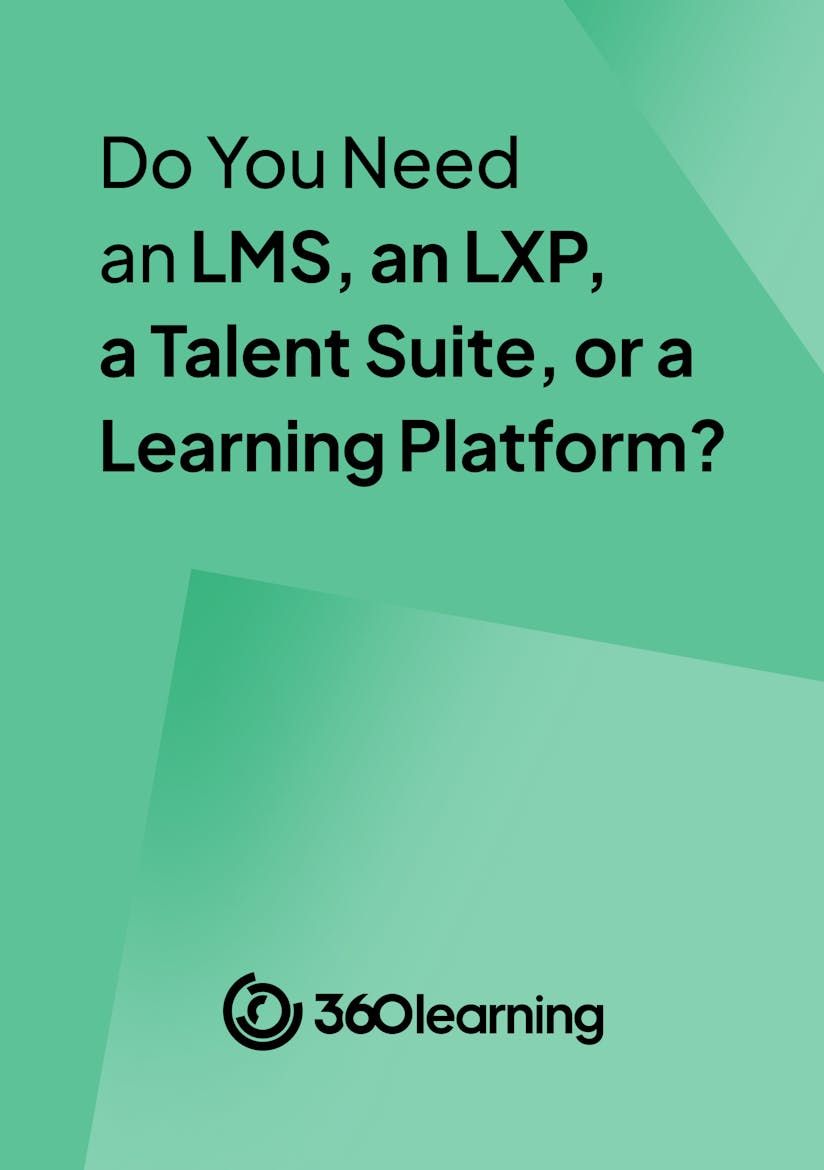
A strong, well-designed learning and development strategy is essential. This is particularly true in enterprise companies where the L&D function services a vast and often geographically dispersed client group.
How can you help hundreds, if not thousands, of people to learn the skills they need for their role while maintaining a consistent learning culture? How can you identify, develop, and deploy the skills your organization needs most?
It's an enormous task, made harder as you try to adjust across locations, languages, and experience levels.
Just as a captain needs GPS and maps to navigate a trans-Atlantic crossing, L&D leaders can only expect to maximize learning outcomes with an effective enterprise learning strategy.
In this article, we share how to create the right enterprise learning strategy for your company. You'll see the benefits of sound implementation, and nine crucial steps to develop a strategy that meets your learners' needs and exceeds business leaders' expectations.
Think of us as your L&D cartographer for the day.
What is an enterprise learning strategy?
A company's enterprise learning strategy outlines the ways in which the company will support employee development aspirations and help people to attain critical new skills. Notably, this support is made possible and enhanced through a learning management system.
This approach involves a range of learning and development techniques and fundamentals that enable the upskilling and training of employees, partners, customers, and clients at the precise moment they need it within a robust learning ecosystem.
Your strategy will consist of a collaborative network of individuals, tools, and resources to foster a learning culture of ongoing learning experiences and information exchange within a company.
If you aim to equip all employees in your organisation with the knowledge and resources they need to carry out their roles in line with the company's business strategy, then a corporate learning strategy is the solution.
Essentially, your strategy outlines the ‘what’ and ‘why’ of your learning and development initiatives. How will you support employees to learn? Why are you prioritising particular initiatives? And what do you hope to achieve as a result?

Overcome LMS decision fatigue
By providing your contact info, you agree to receive communications from 360Learning. You can opt-out at any time. For details, refer to our Privacy Policy.
The benefits of enterprise learning
Implementing an enterprise learning strategy can bring several benefits to your organisation.
Here are four advantages:
1. Help meet business goals
A strong learning strategy ensures that your programs are more than just training. They're targeted tools to help employees excel in their roles and contribute directly to company objectives. By identifying the specific skills needed in each department, you can design learning paths that address real-world challenges and opportunities.
For example, sales teams might receive training in negotiation tactics to boost closing rates, while operations teams might focus on process optimization to cut costs. This alignment creates a direct link between individual development and organizational performance.
Over time, employees feel more capable, engaged, and invested in the success of the business.
2. Generate actionable insights for better decisions
An enterprise learning strategy lets your team track data that goes beyond course completions. By measuring the impact of training on ROI, KPIs, and key business metrics like revenue growth or customer retention, you demonstrate L&D’s value to leadership.
This data-driven approach also enables smarter resource allocation. For instance, if a leadership development course correlates with a measurable drop in turnover, there's clear incentive to invest in it further.
These insights help guide both immediate adjustments and long-term strategic planning for learning initiatives.
3. Support continuous growth and innovation
Foster an environment where professional development is a constant, not a one-off event. Regular upskilling keeps employees adaptable to changing technology, shifting market demands, and evolving customer expectations.
Enterprise learning also reinforces a culture where learning is valued, which in turn boosts morale and encourages innovation. For example, when your teams have easy access to new knowledge and tools, they’re more likely to propose fresh ideas or adopt efficient processes.
Over time, this culture of continuous learning helps your company stay competitive and resilient in the face of industry change.
4. Strengthen brand influence and partnerships
A robust enterprise learning strategy can also enhance your organization’s reputation. When your workforce is skilled, aligned, and knowledgeable, they become ambassadors of your company’s mission and values.
This professionalism and expertise can impress potential partners, reassure current ones, and strengthen your influence within your industry. For instance, a partner might be more willing to collaborate when they see that your team is well-trained and committed to excellence.
Internally and externally, a learning strategy positions your organization as a forward-thinking leader that invests in its people.
So, if you're looking to gain these benefits and more, implementing a learning strategy is essential. The question is, how do you actually create your learning strategy?
9 steps to create an enterprise learning strategy
Building a successful enterprise learning strategy involves the following crucial steps.
1. Conduct a training needs assessment
This first stage of the process helps you determine the essential learning opportunities needed to meet your company's goals. To accomplish this, you need to work with stakeholders, including department heads and company leadership, to identify the knowledge and skills that require training emphasis.
Carrying out a training needs assessment is instrumental in ensuring that training resources are leveraged and offered to those employees who need them.
2. Carry out a skills gap analysis
Next, you need to perform a skills gap analysis to identify the difference between learners' current skills and what they need, as determined in the training needs analysis.
Here at 360Learning, we recommend taking a bottom-up approach to empower individual employees to tell you where their gaps are. Potential tools are surveys, in-person interviews, or a collaborative learning platform that enables employees to declare new learning needs.
The great thing about a skills gap analysis is that you can always return to your data every six months to determine if employee development programs meet their forecasted ROI.
Your skills gap analysis will enable you and your team to consider what learning solutions will best impact those targeted business goals.
3. Align with key business objectives
For your learning strategy to truly matter at the enterprise level, it must connect directly to the goals that business leaders prioritize most. While engagement scores, course completion rates, and learner satisfaction are useful internal metrics, they rarely influence executive decision-making on their own.
Senior leadership is focused on outcomes like increasing revenue, reducing costs, improving customer retention, and building a stronger workforce culture.
Here are a few ways to align L&D with those larger business priorities:
- Link training to revenue growth: Use sales enablement programs to shorten sales cycles and increase average deal size.
- Connect learning to retention: Offer strong onboarding and career development initiatives to reduce turnover and boost employee loyalty.
- Target customer outcomes: Show how product knowledge training directly improves customer satisfaction scores and lowers churn rates.
- Reduce business risk: Deliver compliance, safety, or security training to mitigate legal, financial, or reputational harm.
When L&D outcomes are tied to measurable business impact, it shifts the conversation from “learning for learning’s sake” to “learning as a driver of business success.” This makes it far more likely your initiatives will receive budget, attention, and long-term executive support.
Learning and Development is no longer a cost center, but a catalyst to achieve the company’s most important goals.
4. Determine the right training format
Now it’s time to consider the type of training for your organization's learners after identifying their skills gap and learning needs.
To get you started, here are some common types of training to consider:
- On-the-job
- Online learning, such as eLearning or virtual workshops.
- Peer-to-peer
- Coaching and mentoring
- Instructor-led
- Simulations
- Discussion forums
Crucially, the type of training solution you select depends on the identified skills gap, the employee learning needs, and the resources available to the organization. So, make sure you choose a training type that fits.
Related: Check out our report on the state of learning in the flow of work
5. Prioritize urgent training needs
The next step is a form of triage to decide what to do now, soon, later, and what to keep on hold for now.
You should assess each of the identified learning needs on factors such as the following:
- Organizational impact: Does the identified employee learning need contribute to your organization’s short- and long-term goals?
- Cost of training: What is the estimated cost for the company to address this skill gap? How much will developing the learning content that will have the greatest impact cost?
- Potential ROI: Return on investment is essential for getting stakeholder buy-in and balancing the training cost with the organization's benefit. You can use our free calculator to help measure your training ROI.
- Compulsory compliance requirements: Does the gap identified relate to your organization's regulations, policies, or compliance with laws?
6. Double-check existing systems and resources
Next, you need to ensure your time and investment don't overlap with any existing resources your organization has already developed.
There may be additional resources that you can build on to deploy your learning strategy at a whole enterprise level. Does one department have an instructional asset, such as a webinar, that can be adapted, evolved, or incorporated into your training needs? If so, great. You could save time and money by incorporating it into your strategy.
7. Invest in a learning management system
An enterprise learning management system (LMS) is a software solution for administrating and delivering corporate learning to employees.
You are going to need help deploying your extended enterprise learning strategy. An LMS will help you design, author, and organize your training content and ramp up your learning environment. It will also serve as a central location for storing and distributing course content, enabling you to monitor employee engagement and progress efficiently.
LMS features you should be on the lookout for include the following:
- Course creation tools: You can create courses or training programs to address specific learning needs.
- SCORM compliance: Sharable Content Object Reference Model compliance means you can buy courses from a third-party provider and easily upload them to your LMS.
- Content management: You can customise how various learners utilise the system. For example, administrators set permissions, assign courses, and track completion.
- Analytics: You can analyse how students engage with your courses through metrics like average grades, completion rates, and participant satisfaction.
- In-course feedback: In-course feedback can help you create much stronger courses. Common examples of features include ratings and comments, reactions, and relevance scores.
- Co-authoring tools: Authors can work on the same course synchronously or asynchronously and share input. Platforms that implement co-authoring might have collaborative features such as in-course chat and comment threads, simultaneous editing by multiple users, and user permissions for course review and editing.
When choosing an LMS, ensure you align platform features with your learning objectives.
8. Design and create your training content
Now that you have your LMS solution, it's time to put it to use and start designing and creating impactful content.
With the data from your training needs assessment and skills gap analysis, it's time to work with your team to develop clear learning objectives and a brief content outline to address those learning needs.
To achieve the best learning outcomes, we recommend creating training content that is not only informative but also entertaining, interactive, and useful. Integrating training into the flow of work can also enhance its effectiveness for your team.
Some top tips we’ve heard from L&D experts when designing training materials include leveraging interactive learning, focusing on learner value, sharing training objectives with learners, and catering to different types of learners.
Don’t forget to work alongside your internal subject-matter experts to ensure you capture their know-how and share it amongst your teams–that way, everyone can upskill from within.
9. Time to implement, evaluate, and iterate
The moment has arrived to initiate your enterprise learning strategy and witness its impact on the learning needs of employees and your company's business objectives.
But the work isn’t over yet. It is crucial to continually assess your learning strategy’s effectiveness and relevance to your business objectives while ensuring it addresses any skill gaps.
It's also important to acknowledge that sometimes things don't go quite as planned, even with careful planning. Therefore, it's necessary to be prepared to iterate and improve your strategy as your organization expands and the marketplace evolves.
Examples of enterprise learning in action
Now you have your action plan and the theory behind it. But what does meaningful L&D actually look like in real, enterprise-scale companies? Here are three large companies to learn from.
Michelin
The world's leading tire manufacturer, Michelin has more than 130,000 employees. It's committed to training its entire workforce to succeed both within the company and beyond. And that kind of scale can daunting for L&D teams.
Michelin created its own Talent Factory, where 100 respected employees offer peer-to-peer learning and career development. They've managed to build more than 26,000 personalized training courses, tailored to the skills Michelin employees need.
The key step to achieving this was removing barriers to sharing. Employees need to be able to create course content and share it with colleagues as quickly and easily as possible. The Training Factory's digital-first setup lets them do it, and employees can then take new training courses whenever suits them best.
And despite having hundreds of thousands of employees, Michelin only needs two managers to maintain the Training Factory. It's an extraordinarily scalable, iterable approach to enterprise learning.
See Michelin's other secrets to enterprise Learning.
Safran
With more than 80,000 employees, Safran is a global leader in aerospace engineering. With the rapid rate of technological development, it needs an efficient, scalable way to upskill current employees and train new team members.
Safran's L&D team chose to emphasize collaborative learning through a decentralized learning platform: Safran University. Internal experts use the University's authoring tools (provided by 360Learning) to create learning paths in-house and share knowledge. Employees create, share, and iterate courses based on their subject-matter expertise, with hundreds of thousands of hours of content available to the tens of thousands of active users.
This is the kind of scale and specificity that would normally cost countless hours (and likely millions of dollars) to build. Thanks to internal experts, Safran has a huge volume of highly-relevant learning content to help employees navigate their changing working world.
Read the full story of Safran's Learning and Development success.
Mitsubishi Electric
A leading electronics manufacturer for more than a century, Mitsubishi Electric prides itself on adapting to new consumer needs, with high-quality engineer and support. In the UK alone, it needs to provide more than 2,000 customer engineers with regular training.
To do this, the L&D team uses an 80/20 model: 80% of training is digital, with 20% delivered in person. (Not to be confused with the 70-20-10 model of learning.) This was initially a major shift away from classroom settings, and required serious course creation. But with input from subject-matter experts, authoring content was not only quick, but with maximum topical relevance.
Key results include a massive increase in the number of learners enrolled in and completing courses, a far more efficient L&D team, and training costs reduced by 65%.
But most importantly, 99% of customers are happy with their engineering support, and wait times for help have dropped drastically. It's a textbook example of Learning and Development directly impacting core company objectives for the better.
Build the right enterprise learning strategy with 360Learning
360Learning is the first comprehensive learning platform that uses AI and collaborative features to turn your in-house experts into L&D collaborators.
By combining the elements of an LMS, LXP, and our Academies, our platform makes it easy to implement your enterprise learning strategy while building a collaborative learning culture and upskilling your learners from within.
Here’s how:
- 360Learning fosters internal mobility to solve the talent shortage by empowering companies to upskill from within. By turning their experts into champions for employee, customer, and partner growth, companies upskill their workforce fast to meet tomorrow’s business demands.
- 360Learning's AI empowers L&D admins to create personalised learning experiences, streamline content creation, and align with company objectives Plus, the mobile app lets learners access courses and content on the go.
- 360Learning offers advanced analytics to measure the impact of initiatives and improve organizational performance. Additionally, the learning paths functionality adapts to each learner's progress and learning needs, enhancing their overall experience.
- And there’s a lot more!
With the help of these features and tools, you and your team can establish an enterprise learning strategy, foster a culture of collaborative learning, and upskill employees from within. Keen to hear more from one of our collaborative learning experts? Get in touch for a free demo!




